“I fear the intolerance and prejudice is constantly growing. We have a disease. It’s Jap-baiting and hatred. You have a job on your hands to do to make a dent in it — but I don’t know a more challenging nor more important one. I went through an experience I’ll never forget when I was working on it and learned a lot, even if I accomplished nothing.” – Dorothea Lange
It’s been raining for the past several days. Not drizzling, mind you. I’m talking downpours that have a Noah, send the ark ferocity. While we have sun breaks, the rain is unpredictable and it makes planning outdoor activities, including exercise, feasible only for ducks.
This morning, I was up at first light. Though it seems at least a month early, birds have returned to the area and their exercise of territorial imperative results in a squawking that could wake the dead. There was, however, no rain, so, rather than go to the gym I strapped on a miner’s lamp and headed out the door to walk and accumulate my 10,000 steps in the great outdoors. I usually walk along the river, but this morning I decided to walk into downtown Eugene. My route took me past the Japanese Memorial which I can’t pass without reflecting on what good people allowed to happen.
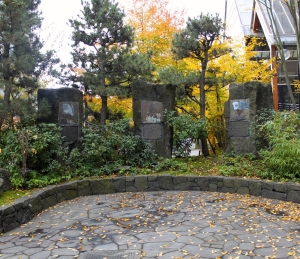
The memorial takes the form of a garden that at this time of year looks waterlogged and forlorn. It stands near the site where Japanese-Americans were assembled prior to deportation to incarceration camps. In the garden, there is a large central sculpture and three stone pillars representing Justice, Perseverance and Honor. The memorial was designed by Kenge Kobayashia who, as a teenager, was incarcerated at Tule Lake camp. Interestingly, most of the money for the memorial came from the Confederated Tribes of Grand Ronde here in Oregon.
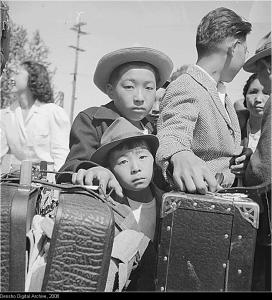
Prior to my walk, I planned to write a humorous post to add to the ruminations I’ve been sharing with you. Instead, I decided to research the internment camps and came across the photographs of Dorthea Lange and Ansel Adams, both of whom were vocal critics of the camps. Thanks to them, we have a vivid pictorial account of life in the camps and what we, as a country did and are capable of doing. Unfortunately, their work was censored during the war, so, few actually got to see what happening in the camps.
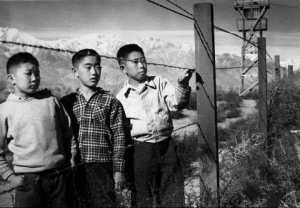
In 1942, President Franklin Delano Roosevelt signed Executive Order No. 9066 into law which eventually forced close to 120,000 Japanese-Americans in the western part of the United States to leave their homes and move to one of ten “relocation” centers or to other facilities across the nation. This order came about as a result of great prejudice and wartime hysteria after the bombing of Pearl Harbor. Those who tried to speak for the Japanese were censored and we put children behind barbwire fences, the only salvation being families were kept together.
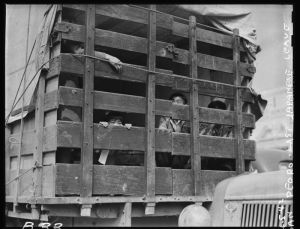
The anti-Japanese sentiment was fanned by the very institutions that should have protected them. “It is said, and no doubt with considerable truth, that every Japanese in the United States who can read and write is a member of the Japanese intelligence system.” This egregious report was issued by the FBI in 1942. Churches added more oil to the flame of negative sentiment. It would take years before our country apologized to the victims of internment. Those are American children jammed into that truck. They don’t look like spies to me. The apology, came 46 years later during the Regan administration. In 1988, President Reagan signed the Civil Liberties Act to compensate more than 100,000 people of Japanese descent who were incarcerated in internment camps during World War II. The legislation offered a formal apology and paid out $20,000 in compensation to each surviving victim, but the law won congressional approval only after a decade-long campaign by the Japanese-American community. This letter, from George H.W. Bush came three years later.
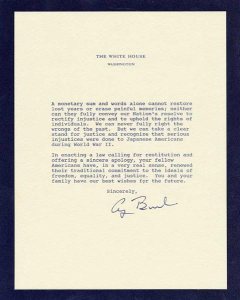
When I see what’s happening at our southern border, I can’t help but reflect on the Japanese-American experience during the 2nd World War. Their incarceration was fanned by ignorance, fear, innuendo and greed. The images of folks in cages makes me wonder about this immigrant nation’s resolve. I’ve heard people argue it’s different this time, but it’s not. What I see is shameful. People are exploiting a powerless group and dehumanizing them in order to make a political point. And it’s hard for me to sit by and watch that happen again. There is little I can do save exercise my franchise and remind others what has happened in the past. February 19th is Remembrance Day for Japanese-Americans. Keep them in your thoughts.

I agree Mary. This smacks of that very embarrassing time during the war. This time they are separating families. A cruel pawn
LikeLike
Too soon we forget the lessons of our past.
LikeLike
The Statue of Liberty must be weeping. I keep thinking of that beautiful poem there that begins “Give me your tired and poor”
LikeLike
Beautifully written, pray fully truth & justice will prevail
LikeLike
Those who cannot remember the past are condemned to repeat it. Or those who cannot read, understand and heed the past will likely try to duplicate it, I am very sorry to say. Your analogy between WWII and today seems singularly apt.
LikeLike
I was in the 3rd grade when Pearl Harbor was attacked. I lived in Santa Clara Valley, California. We had 5 Japanese children in our class of about 22. The girls were dear friends of mine and I can remember their names today even though both of them are gone. We knew these residents of our town were good people. They owned businesses and were farmers. We would have been happy to see them stay in our community but the Press and Congress forced FDR’s hand. He had to do SOMETHING to placate the scary headlines. Ironically, my mother was German but my father was Dutch and we were not sent to internement camps–but our parents had told us to tell anyone who asked that we were Dutch. But it was a scary time, with black-outs and reports of submarines off the coastal waters which caused us all to be cautious.
I feel sad that the history books paint all citizens with a broad brush of bigotry–and that too is happening today.
LikeLike